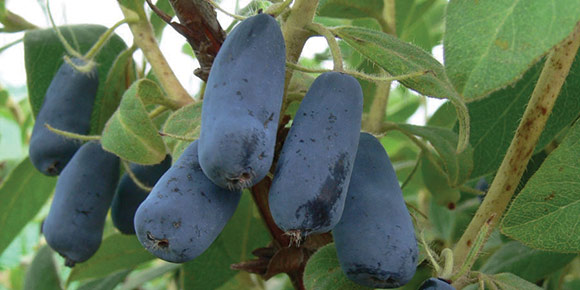Fruit bearing shrubs and trees are somewhat limited in Manitoba, but now everyone can enjoy the sweetness that comes from Lonicera caerulea, the mouthwatering little honeyberry. Also called haskap or blue honeysuckle, the preferred name is honeyberry, because it so well describes the cool, sweet, tangy flavour of this delicious berry.
The honeyberry has been described as tasting like a cross between a blueberry and a raspberry and it’s not as new as you might think. The plant has long been known and used by some communities but it’s just now catching on here because of the work that has gone into breeding bigger and tastier berries. One of the key breeding grounds is the University of Saskatchewan Breeding Program at the Saskatoon campus where they have introduced a number of intriguing and delicious fruit crops over the past decade.
You need two compatible varieties for pollination and fruit set. The fruit is oblong rather than round.
Native to the northern hemisphere, including Russia, where it was a longtime favourite, and Japan, where the name Haskap was coined, the honeyberry is a small shrub that generally grows 1.5 to 2.2 meters (five to seven feet) tall and wide. It also grows wild all over Canada, except for B.C. Unlike the fussy blueberry, which demands a high acidity in the soil, honeyberry is quite tolerant of a large range of soils. The drooping, bell-shaped, creamy white flowers grow in clusters along the stems. Butterflies are attracted to the blossoms.
Honeyberry is ideal for the Winnipeg landscape, being perfectly happy in wet clay soils and part shade but doing even better in a rich organic, well drained location with morning sunlight. It’s a nice compact shrub with small, bright green leaves and a rounded form. It does well as a hedge. Prune it in late winter, early spring while the plant is still dormant
Early varieties ripen with the strawberries while later varieties can still be producing fruit in August and even as late as September.
There are a number of varieties. If you garden in zones 1 to 4, you will want to look at a Russian cross breed. Those in higher zones will look to the Japanese breeds.
The skins simply melt away in processing, an exciting prospect for home cooks and industry alike. Honeyberry can be easily made into jams, juices, wines, ice cream, yogurt and sauces.
Recommended varieties:
Tundra, rated at the top of the list for size, firmness and taste. It is less delicate than some of the others so it is easier to harvest and handle. They are tangy sweet.
Borealis is also high on the list both for flavour and size, but the fruit is quite delicate and requires hand harvesting.
Aurora, released in 2012 and is a companion to ‘Borealis’ for cross breeding purposes. It will also pollinize ‘Tundra’ and ‘Indigo’.
Plant more than one honeyberry for more than a taste of the fruit. Each plant will produce seven to 12 pounds of berries.
Dorothy Dobbie is the owner of Manitoba Gardener magazine. Subscriptions make a great Christmas gift. Call 204-940-2800 or go to localgardener.net.



